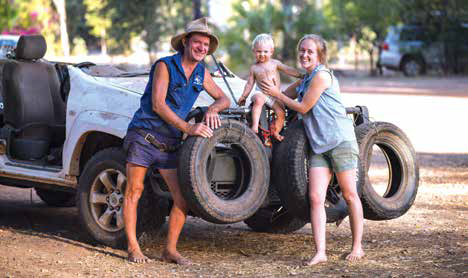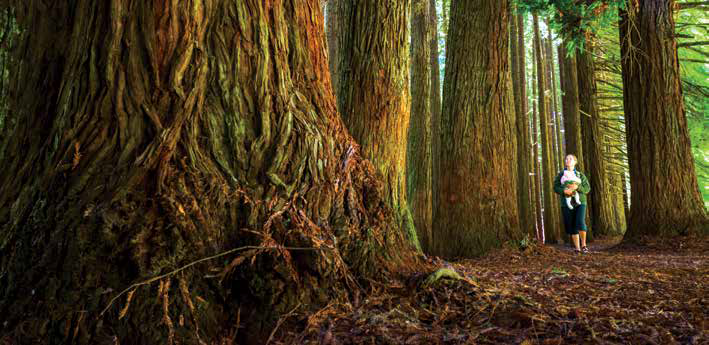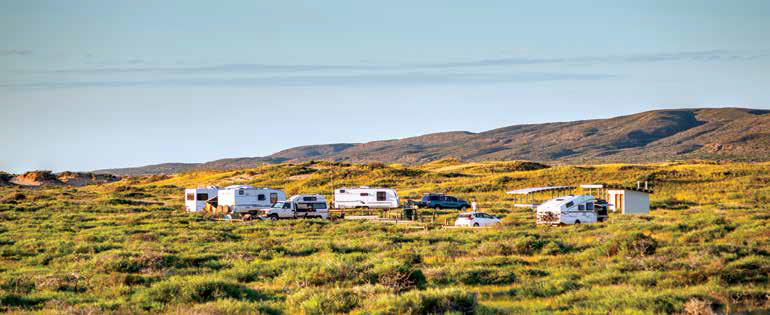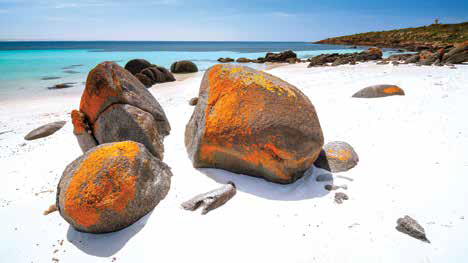
Canunda National Park’s beguiling sweep of sand and sea
Finding places to stay with the family starts with great facilities with lots of fun ways to fill long summer days, and a destination close enough to ward off whinging from the backseat but far enough from home to make the escape seem real. Wherever you live, keep these top spots on your family’s horizon for your next school holiday adventure.
LITTLE ROPER STOCK CAMP (430KM SOUTH OF DARWIN)
It’s the holiday camp for kids where you get to relax, with enough bulls and buffalos to lure kids to the rails, squirrel glider feeding sessions and pythons for kids to cuddle around the campfire. Located close to Mataranka’s uber-popular thermal pools, Little Roper Stock Camp lures a lot of families with its $20-per-night campsites (kids stay for free), and a laissez faire attitude that lets kids be kids.
After soaking and swimming all day long in Mataranka’s twin hot springs, campers gather around the communal campfire for cold ales and chats. At dawn, follow your nose back to the campfire to fill hungry bellies with Johnny cakes for $1 a pop and mugs of free, freshly brewed tea – a Little Roper specialty cooked up by owner and ex-ringer Des Barritt.
There’s a weekly stock camp dinner and show ($50 a head), hot showers and power if you need it, and just before bedtime, Des rounds up the kids to hand feed the squirrel gliders. Little Roper Stock Camp isn’t just one of the cheapest places to stay with kids on the Stuart Highway, it’s also the best and your kids will love it too.
Where: Little Roper Stock Camp is located 430km south of Darwin on Homestead Road in Mataranka, 2km from the thermal pools.
Visit: The camp opens from April to November.
Pack: Snorkelling gear and noodles.
Contact: littleroperstockcamp.com.au

Des, Darcy and Telka run Little Roper Stock Camp
INDIAN OCEAN DRIVE (PERTH TO DONGARA)
Stretching 350km north of Perth, the Indian Ocean Drive hugs a wildly scenic coastline of giant sand bright blue bays where sea lions haul out, and salt lakes and underground tunnels too.
The road trip starts just 50km from the city at Yanchep National Park where there’s an impossible to resist koala viewing platform for curious tots, and caving adventures to thrill your teens. A short drive north, the largest sand dunes in the west tower over Lancelin, perfect for speed demons of all ages with quads and trail bikes.
That Lancelin’s Aboriginal name – Wangaree – means fish, is a clear sign that rods and reels will be required, and with a worldfamous dive trail, sea lion cruises, and Australia’s best kitesurfing, you’ll need plenty of water time in Lancelin. Next up, Nambung National Park sets a slower pace, luring photographers at sunset to capture the Pinnacles’ crumbling limestone spires.
North of Jurien Bay, stake out a site at Sandy Cape Recreation Area or the beachfront Milligan Island campground, and shine your torches through Stockyard Tunnel’s 300 metre-long cave system. There’s free camping at Lake Indoon and by the sea at Cliff Head, and plenty to do when you finally reach Dongara.
Where: The Indian Ocean Drive follows the coast for 350km from Perth to Dongara.
Visit: Year-round.
Stay: Cliff Head’s three beachfront freebies.
Pack: Kiteboarding gear, kayaks, bikes, dive gear and fishing rods.
Contact: parks.dpaw.wa.gov.au.

First stop on the Indian Ocean Drive - Yanchep’s koalas
CANUNDA NATIONAL PARK (43KM WEST OF MT GAMBIER)
A surprising find for families, this beguiling sweep of sand and sea flies under the radar on South Australia’s rugged limestone coast. Head here with kids who like to fish, beachcomb and play by the sea, and marvel at shell middens and giant dunes, blowholes and teetering sea stacks.
Closest to the cosy seaside village at Southend are two top campgrounds and trailheads for short walks. Beyond here, a 65km long 4WD track explores the national park, climbing to Kyber Pass across shifting dunes and pushing east along Geltwood Beach to Lake Bonney and Cape Banks Lighthouse.
There are six campgrounds with easy access of local towns, and if you set a South Australian registered cray pot overnight, you could be feasting on southern rock lobster for breakfast.
Where: Canunda National Park is
located 43km west of Mt Gambier.
Visit: Spring to autumn.
Stay: National Park campsites at Kotgee and Nal-a-wort (near Southend), Geltwood Beach, Number Two Rocks (4WD-only), Oil Rig Square and Cape Banks Lighthouse. Park entry is free.
Pack: A cray pot and fishing gear.
Contact: parks.sa.gov.au.

Freycinet’s Wineglass Bay is famously photogenic and great fun for kids too
FREYCINET NATIONAL PARK (194KM FROM HOBART)
For mesmerising seascapes and outdoorsy fun, no Tassie hotspot entertains quite like Freycinet. Don’t miss a hike to magnificent Wineglass Bay, or the chance to explore the peninsula by sea. Seakayak to Hazards Beach, go snorkelling at Sleepy Bay, birdwatch at Moulting Lagoon and surf the swell off Friendly Beaches where you can free camp for up to two weeks and watch wombats ambling around your van.
The track around Cape Tourville is stroller-friendly (600m) and there are migrating Southern right whales to spot enroute. With lots of wildlife to spot and enough places to eat and drink to maintain a happy holiday vibe, no one does it tough while camping at Freycinet. When you go, don’t miss the free, guided walks and talks, held over the summer school holidays.
Where: Freycinet National Park is
194km from Hobart on Tassie’s East
Coast.
Visit: Summertime.
Stay: Bush camp at the Friendly Beaches (free, toilets only) or book a powered site at Richardsons Beach.
Pack: Kayaks, surfboards, SUPs, snorkelling gear and daypacks.
Contact: parks.tas.gov.au.

Bunya Mountains’ high altitude camping haven
BUNYA MOUNTAINS (230KM FROM BRISBANE)
This high-altitude haven, just a three-hour drive from Brisbane, provides the perfect escape from Queensland’s stifling summertime heat. With prolific birdlife, cool rainforest trails and the world’s largest, natural stand of bunya pines, Bunya Mountains National Park will more than impress wildlife lovers.
Get up close to red-tailed wallabies and koalas, spot bats and colourful Boyd’s forest dragons, and arm the kids with torches to track down mountain brushtail possums and ringtail possums on the rainforest’s edge after dark. Kids will love the bird feeding sessions that lure in bright flocks of crimson rosellas and Australian king-parrots, four times daily. Buy a tray of seeds for $5 per child.
There are excellent facilities at Dandabah campground, including a restaurant, cafe, whisky bar and general store, and kids will enjoy the easy strolls to Paradise Falls and the summit of Mt Kiangarow (2.3km/1hr return), picnicking above Cherry Plain and watching the sunset from Bottle Tree Bluff.
Where: Bunya Mountains is located 230km from Brisbane via the Warrego Highway.
Visit: Yearround.
Stay: Dandabah village has a restaurant, cafe, general store, bottle shop and a whisky bar. Spacious campsites (book in advance) come with hot showers, coin-operated electric BBQs, toilets and tables.
Pack: Walking shoes, torches and insect repellent.
Contact: thebunyas.com.au, nprsr.qld.gov.au.

Set up camp by the sea in Cape Range National Park
KANGAROO VALLEY (150KM SOUTH OF SYDNEY)
At this special campground on the Kangaroo River, the joyful cries of kids at dusk herald the arrival of the bare-nosed wombats. They wander about, nonchalantly nibbling their way around Bendeela Reserve and patiently ignoring campers and their clicking cameras.
By dawn the wombats are back in their burrows and kids take over the grassy camp, swimming and paddling canoes and dangling fishing lines in the river. There’s plenty of room for families to stretch out, and while facilities are limited to toilets, drinking water and canoe launches, stays here are free (just remember to leave the dogs at home).
The wombat encounters are a big drawcard, but with Fitzroy Falls close by and Nowra just 20km away you can factor in some forest and beach time too.
Where: Bendeela is 150km south of Sydney (20km north of Nowra).
Visit: Year-round.
Stay: Camping is free (toilets, drinking water, canoe launches and a dump point).
Pack: Canoes, kayaks and water toys.
Contact: waternsw.com.au.

Discover the Otways’ Californian Redwoods
THE OTWAYS (200KM FROM MELBOURNE)
On the high country that flanks Victoria’s famously crumbling coastline, the Otways’s ancient forests provide excellent natural playgrounds for kids. It’s not all hiking trails and waterfalls either. Dare kids onto the zipline at Otway Fly Treetop Adventures to whizz past rainforest giants at lightning speed.
A thrilling two-and-a-half hour fly through the forest is a top holiday splurge at $80.75 for kids, $114 for adults and $356.25 per family. You can test your mettle on Forrest’s 65km of mountain biking trails, suitable for beginners and pros alike, go fishing at West Barwon Reservoir and spot platypus at Lake Elizabeth – all within easy reach of the free camp at Stevensons Falls.
Elsewhere in the Otways you’ll discover chilly pools to cool off in, and the uber-cute village at Beech Forest is close by for icecreams and coffee.
Where: Beech Forest is located 200km west of Melbourne.
Visit: Late spring to early autumn.
Stay: Free camp at Dandos (near Gellibrand) or Stevensons Falls (near Barramunga). Both accommodate RVs with toilets, tables and fireplaces provided (BYO water and wood).
Pack: Fishing rods and mountain bikes.
Contact: visitotways.com.

Free camp at Bendeela Reserve and unleash the kids on the Kangaroo River
CAPE RANGE NATIONAL PARK (550KM FROM KARRATHA)
Australians are never shy of a road trip, and from as far away as Perth and Broome, holidaymakers converge on Australia’s most accessible coral reef each summer. It’s because Ningaloo Reef sweeps so close to the shore that kids can step right off the sand and ogle sleepy leopard sharks and green sea turtles, joining an endless procession of colourful wrasse and parrotfish.
Overlooking calm turquoise bays and glaringly white sand beaches, rustic national park nooks claim prime real estate in Cape Range National Park, costing $28 a night for a family of four. Powered sites at nearby Ningaloo Lighthouse Holiday Park start from $35/couple plus $6 per child, and is close to the beginners surf break and turtle rookery at Hunters Beach.
Long days at Ningaloo are spent snorkelling Turquoise Bay’s drift dive, paddling kayaks up Yardie Creek to spot rock wallabies, and watching turtles nesting and hatching on nightly tours from November to February.
Located roughly halfway between Perth and Broome, Cape Range National Park is accessible via the tiny town of Exmouth, where you can stock up on essentials, including drinking water, for extended stays at the national park’s top beachfront camps. Boat cruises through Yardie Creek Gorge and the park’s nocturnal turtle tours are both affordable, family-friendly and not to be missed.
Where: 550km south of Karratha.
Visit: Year-round.
Stay: Fees apply.
Pack: Snorkelling gear, kayaks, fishing rods, surfboards, beach toys and hiking shoes.
Contact: parks.dpaw.wa.gov.au, ningalooturtles.org.au.

For translucent bays and squeaky white sand beaches, head to Lincoln National Park, SA
PORT LINCOLN (340KM FROM PORT AUGUSTA)
For beach-play, monstrous, tumbledown sand dunes, sailing and paddling, you won’t find a bigger playground than Port Lincoln. Load up every kind of board you own and unleash the kids on a bay three times the size of Sydney Harbour, retiring afterwards to one of 15 beachfront campgrounds in picturesque Lincoln National Park.
You can even rent a family-friendly park cabin and spend long, actionpacked days four-wheel driving to translucent coves and the top of the enormous Wanna Dunes. Spot the century-old timber sailing ketch at Mary Ellis Wreck Beach, and if you are looking for the best place to swim, start with my favourite - Taylor’s Landing - with a gorgeous white-sand beach, see-through seas and curious sea lions too.
A short drive away on the other side of the Eyre Peninsula, Coffin Bay’s calm water channels and tranquil inlets are perfect for beginner paddling and sailing, and you can’t leave without sampling some excellent Coffin Bay oysters.
Where: Port Lincoln is located 340km south-west of Port Augusta.
Visit: Year-round.
Stay: At one of 15 campgrounds in Lincoln National Park.
Pack: SUPs, kayaks and fishing rods.
Contact: parks.sa.gov.au.
Please note, prices and information correct at time of print.
Category: Features
Written: Fri 01 Nov 2019
Printed: November, 2019
Published By: